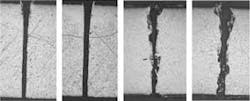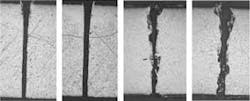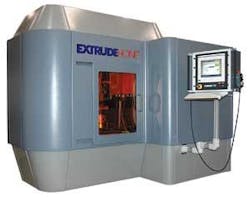Two pulses are better than one
Nanosecond laser technology provides material removal rates consistent with longer-pulse, higher-energy laser systems, while maintaining the quality representative of ultra-short-pulse systems
Randy Gilmore, Mike Armas, and Andrew Forsman
A new nanosecond solid-state laser machining technique, known as SuperPulse, has been the subject of a research and development program aimed at providing high machining rates, while preserving the quality level typical of femtosecond laser systems.
A SuperPulse is actually a pair of two closely timed (commonly <200 ns separation) laser pulses that act in concert to remove more material than would be removed by the pulses if they were fired independently.
The high focal spot irradiance resulting from the primary pulse in this pair creates a hot plasma and ablates the target material. It is believed the temperature of this plasma exceeds 20,000 K. The hot plasma dissipates rapidly, on a time scale measured in tens of nanoseconds and exposes liquid, vapor, and other target material remaining in the immediate vicinity of the point where the laser struck the target.
After the hot plasma has dissipated, the second pulse strikes the part. Because this pulse is fired before the residual liquid and vapor has had a chance to dissipate, the secondary laser pulse does not strike the target surface but strikes this debris instead, heating it to temperatures that again are believed to exceed 20,000 K, based on thermal emission measurements. The debris cloud absorbs the laser energy.
After the secondary laser pulse, sufficient time is allowed for all plasma and debris to dissipate before firing the next pair of pulses. At a fundamental level there appears to be two key differences between this method and conventional techniques:
(1)Conventional techniques frequently treat any and all material that the laser causes to be removed from the target, whether in the form of plasma, vapor, liquid, or other debris, as parasitic material that must be removed prior to applying the next laser pulse. SuperPulse uses this debris in a productive fashion, to increase the efficiency of laser ablation.
Conventional techniques frequently rely on auxiliary techniques such as gas jets and vacuum to inhibit material redeposition inside holes and slots. SuperPulse provides an additional technique, namely the reheating of debris that may otherwise adhere to the walls of the holes and slots instead of flowing out and away from the target.
In the comparison presented in Figure 2, the laser wavelength is 532 nm, the pulse duration of the conventional technique pulse is 4 ns, and the pulse duration of the primary and secondary pulses of the new technique is 4 ns. The total energy of each technique is identical; the only difference between the two techniques is that whereas the conventional technique applies the laser energy to the target all at once in a single pulse, the SuperPulse technique splits the same amount of energy into the carefully timed primary and secondary pulses. The laser fires at 10 kHz for both, but the average power is unchanged.
The differences between the two techniques have a profound impact on the results of laser drilling (see Figures 1 and 2). The figures compare percussion drilling rates between conventional and SuperPulse techniques in three materials: aluminum, titanium, and tool steel. The data is presented as the material removal rates for through holes of different depths. Although the results depend on the material being drilled, the SuperPulse technique clearly offers a significant advantage. Three principal improvements are noted:
(1) Improved drilling speed
(2) Improved hole quality
Improved repeatability of hole shapes for all drilling times
Finally, the improved drilling efficiency and material flow, and the correspondingly reduced drilling times, mean that less thermal energy is deposited into the holes, which can cause metallurgical changes such as grain growth. Figure 3 shows an example of a hole that has been drilled with no visible changes to grain size.
Laser machining system
The research and development program in which Extrude Hone and General Atomics have been involved has already yielded two laser machining systems. The first was a laboratory version test bed, which provided a five-axis motion platform to allow manipulation of the workpiece in several axes, similar to those movements anticipated to be required for the applications identified by an initial applications study. The test bed provided an open architecture, which was easily modified to make experimentation possible on workpiece fixturing, angle of attack of the laser beam to the workpiece, and metrology systems to locate the workpiece and evaluate the quality of features machined by the system.
Following completion of the test bed system, specifications for a prototype short-pulse laser machining system were developed. Based on these specifications a prototype system was designed, manufactured, tested, and demonstrated. The system-which was displayed at the International Manufacturing Technology Show in Chicago in September of 2004-incorporated five axes of workpiece motion, relative to the laser beam in the X, Y, Z, B, and C axes (see Figure 4).
In addition to these five primary axes, a trepanning head for laser beam manipulation was incorporated into the system. The four-axis trepanning head permits the drilling of various diameter holes at a controlled taper inclination angle. Utilizing this new design approach, it is now possible to change the trepanning diameter continuously, in synchronization with other machine axes. Additionally, the angle of trepanning can be adjusted synchronously with any of the other machine motions. This ability should permit the machining of three-dimensionally shaped features through, or into, a workpiece.
Applications
One primary application of this technique involves the United States Army, which is particularly concerned with producing diesel fuel injector nozzles (see Figure 5) that are capable of delivering more efficient fuel economy. Because the Army consumes approximately 600,000 gallons of diesel fuel daily in a peacetime environment-representing some 40 percent of the tonnage of all material moved forward on the battlefield-fuel conservation is of high importance. The ability to produce diesel injector nozzles that can provide a two percent or greater fuel savings represents savings in the millions of dollars or more annually.
By machining the spray orifices in the diesel injector nozzles to a smaller diameter, the atomization of the fuel delivered from the nozzles is optimized and yields a cleaner, more efficient combustion cycle. While the Army goal is to reduce fuel consumption, commercial users of diesel injectors manufactured by nanosecond laser machining will realize lower emissions, due to the more efficient combustion cycle that results when the fuel spray is more efficiently atomized.
A secondary application for short-pulse laser machining is the ability to produce cooling holes in aircraft turbine components, such as turbine blades. In modern military aerospace engines, turbine temperatures can exceed the melting point of the materials from which the engine is made. Therefore, providing cooling to the turbine blades is highly important. Higher turbine temperatures provide greater thrust and superior fuel economy. As turbine temperatures rise, more temperature-resistant materials are used for the fabrication of turbine components. Today turbine blades are constructed from single-crystal materials and are often clad with a thermal barrier coating. The thermal barrier coating is often non-conductive, making electrical discharge machining (EDM) no longer applicable to the installation of cooling holes. The SuperPulse laser system has demonstrated the ability to machine through these thermal barrier coatings and the single crystal substrate material, with no adverse affects to either material.
Additional applications for short-pulse laser systems include medical applications, such as stents and spinal implants, semiconductor manufacture, inkjet spray nozzles, and spinnerets used in the manufacture of textiles. In the final year of the research and development program, further exploration will be done into other applications for short-pulse laser machining.
Randy Gilmore is with Extrude Hone Corporation (Irwin, PA) and Mike Armas and Andrew Forsman are with General Atomics. Collaborating authors include Mike Perry, Dmitri Gaidarenko, Aaron Dodell, and Mike Hoppe with General Atomics and Bill Johnson with Extrude Hone Corp. For more information, contact [email protected].
SuperPulse system
Extrude Hone Corporation, acting as prime contractor, has engaged General Atomics Photonics Division (San Diego, CA), owner and developer of the SuperPulse laser and process technology (US Patent No. 6,664,498, Forsman et. al.), to partner in the development of high accuracy laser machining systems. The laser provides <4ns laser pulses having energies that exceed 2 mJ, and hence is capable of efficiently coupling the laser energy to the workpiece.
General Atomics Photonics Division’s Everest laser line is the building blocks for the SuperPulse laser. While the SuperPulse format is not limited to any one specific laser, the Everest line, with the shortest pulsewidth and highest peak power of any laser in its class, makes it the ideal laser for implementation of this technique.
The Everest product family is designed using a modular approach that allows the product family to be flexible and address many different markets. The first module and the heart of all the Everest products is the Everest 1064-2, a short-pulse, rugged oscillator module. The next module is a master oscillator power amplifier; this module combines the Everest 1064-2 oscillator module with a power amplifier module to produce the flagship of the product line, the Everest 1064-25. Combining the Everest 1064-25 module with a second harmonic module produces the Everest 532-15, the basis of the SuperPulse. The SuperPulse laser uses the Everest technology with advanced timing circuitry and software to create the world’s most advanced industrial diode-pumped solid-state laser.







